A data grid allows users to view, edit, and analyze object data in a spreadsheet-style format. Users with permission to view a data grid can interact with it by:
- Resizing, sorting, and showing or hiding columns;
- Editing an object's properties (Name and Description) or fields (Text, Numeric, Date & Time, and Select List) within individual cells (if Edit permissions have been enabled on your role and in the data grid settings);
- Viewing an object's details in a palette (if enabled);
- Filtering data by state, role, relationship, reference, or single select list;
- Wrapping or unwrapping cell contents; and
- Moving forward or back through the grid's pages or adjusting the number of rows displayed on a single page.
 | Refreshing your browser or navigating away from a data grid will reset any custom display settings (show/hide columns, column width, sorting, etc.) to its default configurations. |
This article provides information and instructions on accessing, viewing, and editing data in a data grid from a view. For information on creating a data grid, see the Create a New Data Grid article.
 A data grid as it appears to end-users in a view.
A data grid as it appears to end-users in a view.
To view a data grid:
- Navigate to the application and activity where the data grid is saved.
- Click an anchor (root) object in the view to display the data grid.
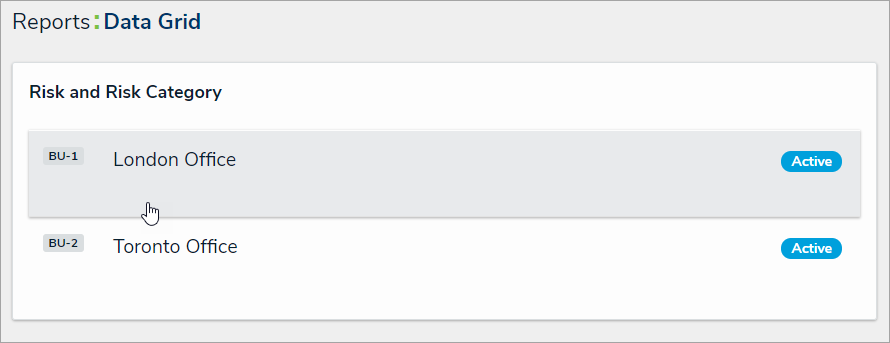 Clicking on an anchor object to view a data grid.
Clicking on an anchor object to view a data grid.
- To open a grid object in a palette, hover your cursor over a cell in the Name column, then click the
 icon. This icon will only appear if the palette option was enabled by an administrator and if the Name column is displayed on the grid.
icon. This icon will only appear if the palette option was enabled by an administrator and if the Name column is displayed on the grid.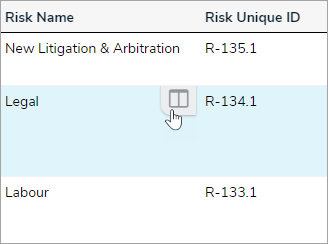 The palette icon in the Name column.
The palette icon in the Name column.
- To edit property (Name or Description) or field data (Plain Text, Numeric, Date & Time, or Select List) in a column that has not been marked as read-only, click the cell, then type your changes or make a selection from the available options. Changes made to cells are applied to the associated object and are saved automatically.
 Clicking a cell to edit it. If the cell has been marked as read-only or your role does not have permission to edit the associated object, the cell cannot be edited.
Clicking a cell to edit it. If the cell has been marked as read-only or your role does not have permission to edit the associated object, the cell cannot be edited.
- To edit a text field with rich text formatting enabled, click the cell to open the RTF editor, type your changes, then click the
 icon to save. If you don't have permission to edit the RTF field, clicking it will display the fields' contents in focused mode. Click x to close the RTF editor or window and return to the data grid.
icon to save. If you don't have permission to edit the RTF field, clicking it will display the fields' contents in focused mode. Click x to close the RTF editor or window and return to the data grid. - To adjust a column's width, hover your cursor over the top of the column to show the
 icon, then click and drag the column to resize it.
icon, then click and drag the column to resize it. - To sort the grid by column, click the column name at the top of the grid to sort the data alphabetically in ascending order. Click the column name again to sort in descending order. Clicking the column name a third time will remove any sorting.
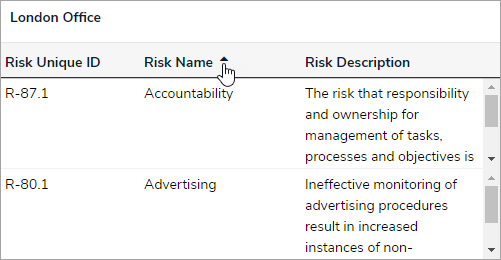 Sorting the columns in a grid.
Sorting the columns in a grid.
- To display a specific grid page, click the < or > icons to move forward or back, click the textbox and type the page number you wish to view, or click the arrows, then click away from the text box to reload the grid. To adjust the number of rows displayed, select an option from the row dropdown menu.
 Changing the grid page.
Changing the grid page.
- To configure the grid's display, click the
 icon in the top-right corner of the page. To show or hide columns, select or deselect the column checkboxes. Select the Wrap Cells or Overflow Cells options to wrap or unwrap the data. Select the Display colored cells as ovals checkbox to show formula or select list cells as text with colored circles instead of a full background color. This option does not apply to workflow states.
icon in the top-right corner of the page. To show or hide columns, select or deselect the column checkboxes. Select the Wrap Cells or Overflow Cells options to wrap or unwrap the data. Select the Display colored cells as ovals checkbox to show formula or select list cells as text with colored circles instead of a full background color. This option does not apply to workflow states.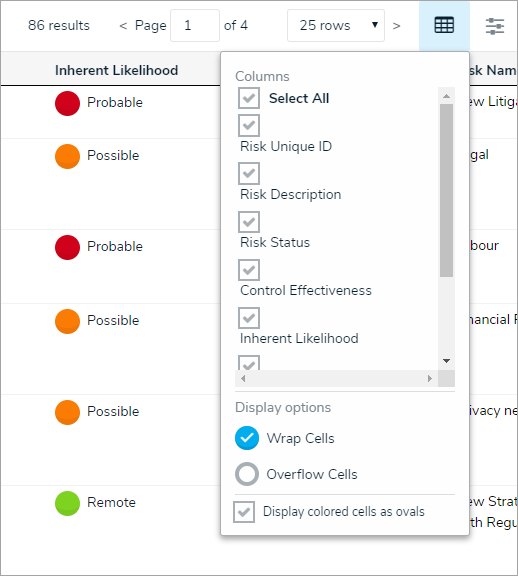 The grid's display options.
The grid's display options.
- To filter the data displayed in a column by single select list, date, workflow state, formula range, relationship/reference, or role, click the
 icon to the far right of the page to enable filters below the column headers, then begin typing keywords or select an option. Click the
icon to the far right of the page to enable filters below the column headers, then begin typing keywords or select an option. Click the  icon again to disable/reset any filters.
icon again to disable/reset any filters.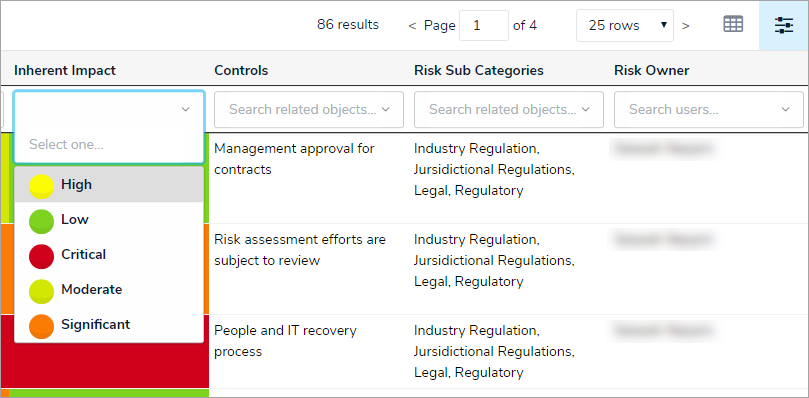 Filtering the data displayed in the grid.
Filtering the data displayed in the grid.
- To reset any custom display settings, including filters, column widths, hidden columns, page numbers, or rows, refresh your browser.

 icon. This icon will only appear if the palette option was
icon. This icon will only appear if the palette option was 

 icon to save. If you don't have permission to edit the RTF field, clicking it will display the fields' contents in focused mode. Click x to close the RTF editor or window and return to the data grid.
icon to save. If you don't have permission to edit the RTF field, clicking it will display the fields' contents in focused mode. Click x to close the RTF editor or window and return to the data grid. icon, then click and drag the column to resize it.
icon, then click and drag the column to resize it.

 icon in the top-right corner of the page. To show or hide columns, select or deselect the column checkboxes. Select the Wrap Cells or Overflow Cells options to wrap or unwrap the data. Select the Display colored cells as ovals checkbox to show formula or select list cells as text with colored circles instead of a full background color. This option does not apply to workflow states.
icon in the top-right corner of the page. To show or hide columns, select or deselect the column checkboxes. Select the Wrap Cells or Overflow Cells options to wrap or unwrap the data. Select the Display colored cells as ovals checkbox to show formula or select list cells as text with colored circles instead of a full background color. This option does not apply to workflow states.
 icon to the far right of the page to enable filters below the column headers, then begin typing keywords or select an option. Click the
icon to the far right of the page to enable filters below the column headers, then begin typing keywords or select an option. Click the  icon again to disable/reset any filters.
icon again to disable/reset any filters.